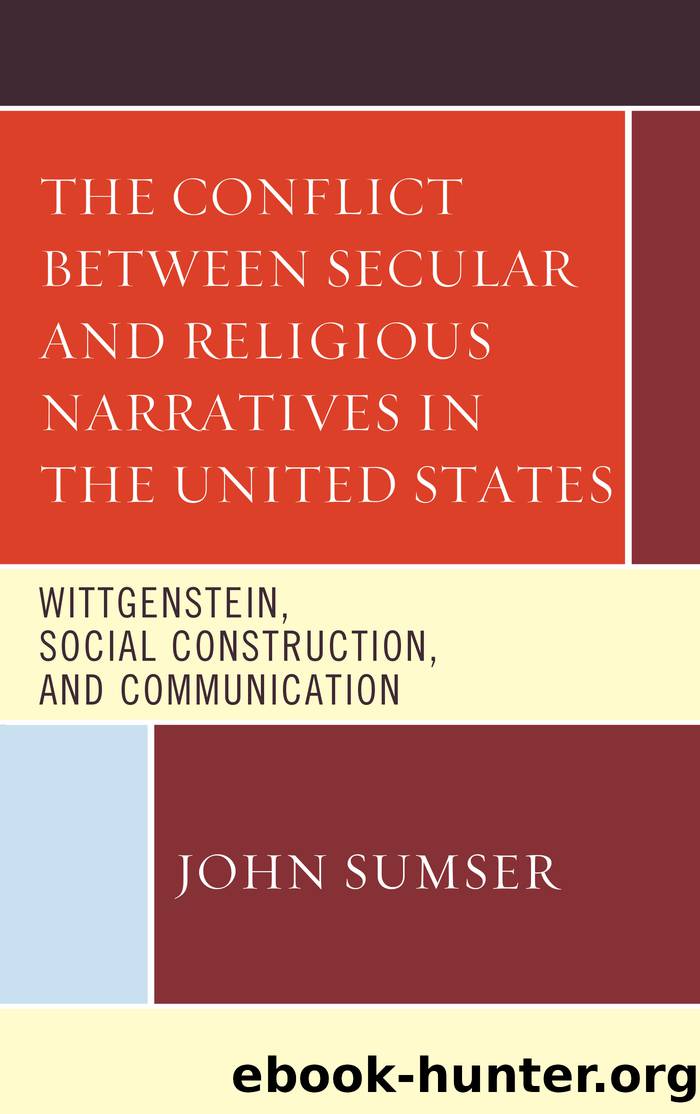The Conflict Between Secular and Religious Narratives in the United States by Sumser John;

Author:Sumser, John;
Language: eng
Format: epub
Tags: undefined
Publisher: Lexington Books/Fortress Academic
Published: 2012-08-15T00:00:00+00:00
Conservative Christians actively seek to homogenize their social networks, thus removing any social divisions and increasing the gap between themselves and their perceptions of outsiders. For fundamentalists, âcommuning with persons of other faiths or people who do not adhere to a faith is seen to create the potential for spiritual pollution and temptation to sin.â[44] Research has shown that religious fundamentalism is related to negative attitudes toward African Americans, women, communists, and, of course, homosexuals.[45] Darren Sherkatâs research strongly suggests that the fundamentalist distrust of outsiders is responsible for the routine underrepresentation of conservatives in public opinion polls.[46] James Waller, a social psychologist looking at the idea of evil, cites researchers who have found that the greater the homogeneity and social isolation of a group the more likely their views are to become extreme.[47] Looking at the research on group identity, Peter Burke and Jan Stets write that one reason people seek group membership in order to reduce uncertainty and, once members, they âact in concert, identifying and evaluating themselves and others in the group positively and identifying and negatively evaluating others not in the group. From this develops a sense of âweâ and âusâ (toward the in-group), and âthemâ and âtheyâ (toward the out-group).â[48]
This sense of pollution and of evil slipping in from outside the community was seen in the controversy in Utah over the film Brokeback Mountain. The film, which told the story of a homosexual relationship between two cowboys, was pulled from one of the major theater chains in Utah. According to Brenda Cooper and Edward C. Pease, who analyzed how the controversy played out in the Utahan newspapers, those who supported the ban on the film âall referenced the decadent morals of both sexual minorities and Hollywood. Their primary argument was that Utahâs culture needed protecting from immoral outside influences.â[49] And this was not seen as simply a clash of cultures, but as a deliberate attack on Utahâs conservative religious culture. One letter to the editor said that the âagenda of the entertainment industry (is) to degrade the morals in our society.â[50] Thus, it was not that secular morality could erode religious morality (i.e., that some people would find it more attractive), but that the moral content of Hollywood films was designed to undermine more traditional views; it was part of their agenda. This sense of a conspiracy to undermine traditional values is seen by the sociologist Steve Bruce as âa simple continuation of a style of thought which lies at the heart of most traditional religions.â[51] The creation of insiders and outsiders that is such a central aspect of religion, Bruce is saying, combined with the tendency to insert agency into all explanations readily shades into the projection of enemies, plots, and paranoia onto all experience.
Social identity theory, which was developed to explain social conflicts and biases, both reinforces Douglasâs grid idea and sets it in motion. The grid is not static, not simply a place in which people find themselves, but is instead a process in which forms of life are created and sustained.
Download
This site does not store any files on its server. We only index and link to content provided by other sites. Please contact the content providers to delete copyright contents if any and email us, we'll remove relevant links or contents immediately.
Cecilia; Or, Memoirs of an Heiress — Volume 1 by Fanny Burney(32043)
Cecilia; Or, Memoirs of an Heiress — Volume 3 by Fanny Burney(31447)
Cecilia; Or, Memoirs of an Heiress — Volume 2 by Fanny Burney(31398)
The Lost Art of Listening by Michael P. Nichols(7150)
We Need to Talk by Celeste Headlee(5407)
Asking the Right Questions: A Guide to Critical Thinking by M. Neil Browne & Stuart M. Keeley(5350)
On Writing A Memoir of the Craft by Stephen King(4656)
Dialogue by Robert McKee(4156)
Pre-Suasion: A Revolutionary Way to Influence and Persuade by Robert Cialdini(3968)
I Have Something to Say: Mastering the Art of Public Speaking in an Age of Disconnection by John Bowe(3774)
Elements of Style 2017 by Richard De A'Morelli(3233)
The Book of Human Emotions by Tiffany Watt Smith(3136)
Fluent Forever: How to Learn Any Language Fast and Never Forget It by Gabriel Wyner(2913)
Name Book, The: Over 10,000 Names--Their Meanings, Origins, and Spiritual Significance by Astoria Dorothy(2834)
Good Humor, Bad Taste: A Sociology of the Joke by Kuipers Giselinde(2821)
Why I Write by George Orwell(2771)
The Grammaring Guide to English Grammar with Exercises by Péter Simon(2644)
The Art Of Deception by Kevin Mitnick(2621)
Don't Sleep, There Are Snakes by Daniel L. Everett(2496)
